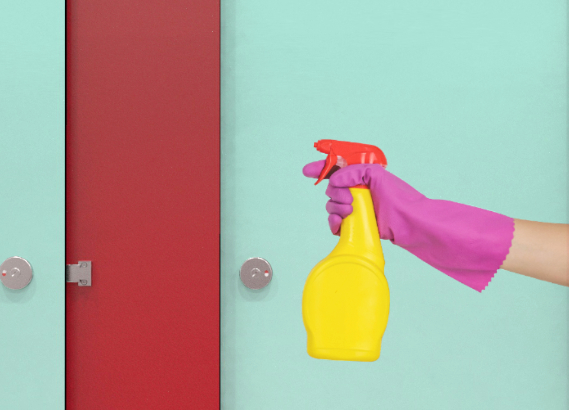How to Clean Toilet Cubicles
Proper maintenance and cleaning of your toilet cubicles can increase their lifespan and keep them from looking worn and old. We’ve compiled a list of do’s and don’t when it comes to looking after your cubicles.
Do’s
High Pressure Laminates and Solid Grade Laminates have a hard, durable, non-porous surface, which generally does not require anything other than normal cleaning with water and a soft cloth or sponge. Light dirt or stains can be removed easily with a soft, non-abrasive cloth using mild domestic detergent (non-alkaline) added to warm water. More stubborn marks may be gently removed using a diluted, mild household bathroom cream cleaner. Always rinse well and dry with a soft cloth.
Graffiti, paint or grease may be removed with a solvent based cleaner, such as acetone or cellulose spirit. Whenever using such cleaning products, please refer to the manufacturer’s instructions and guidelines on use.
If bleaches, hair dyes, caustic alkalis, strong mineral acids and concentrated fruit juice are spilled onto laminate surfaces, they must be removed as quickly as possible and the area cleaned with water and a soft cloth.
Dont’s
Always avoid the use of harsh abrasives, scouring powders, acids, alkalis and harsh chemicals such as toilet cleaner. These cleaners can dull, scratch or etch the surface of the laminate, making it susceptible to staining and discolouration. Mould and bacteria can thrive inside scratches.
When cleaning or rinsing MFC and High Pressure Laminates, take care not flood the surface, especially near seams and edging strips. Liquids can penetrate and cause the substrate to swell. Please note that Solid Grade Laminate has a waterproof core and can be hosed clean, provided that no other materials form part of the washroom or panel construction.
Extra care should be taken when cleaning gloss surfaces. Do not use scouring cleaners or pads as these will scratch the gloss finish. It is inadvisable to use polish on any laminate surfaces as unsightly streaking will occur. Laminates are anti-static and therefore do not attract dust. So they do not require any treatments with wax or wax-based products and these products will form a sticky layer on the surface, which retains dirt.
Heat and Hot Objects
Laminate surfaces have good resistance to the effects of heat however Prolonged exposure to high temperatures may cause de-lamination, so exposure should be limited to short periods of time.
Laminate surfaces are also resistant to cigarette burns, though this should be avoided. Do not expose the laminate to direct flame as this will cause scorch marks, blistering and de-lamination.
Scratch and Impact Protection
Laminate surfaces are resistant to scratches and impacts under normal use conditions.
Do not slide ceramic or abrasive objects across the surface, as this can scratch or cause premature wear. Never use abrasive cleaners, steel wool or sandpaper on laminate surfaces.
How to Maintain Toilet Cubicles
General Maintenance
Hinges and locks should receive occasional lubrication with a light machine or aerosol oil. Take care to remove excess liquid.
Fixings, bolts, hinges and channel brackets should be checked periodically for security.
Cubicle Lifespan
When correctly installed in the appropriate environment and properly maintained cubicles should have an indefinite lifespan. Durability will be reduced due to abuse and mistreatment.
